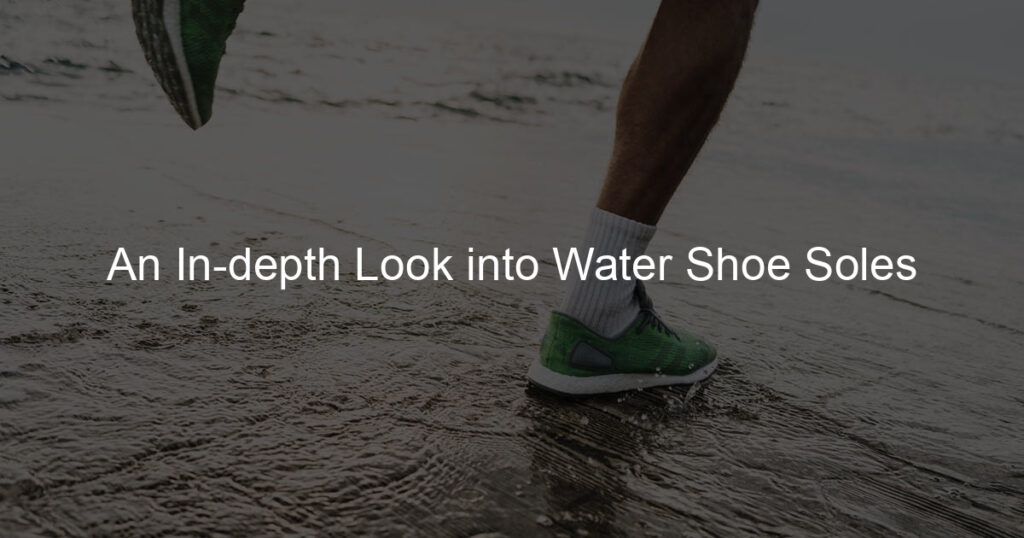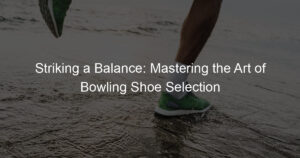As an outdoor enthusiast, I’m always invested in finding the best gear for my various adventures.
One essential piece of equipment I’ve come across recently is water shoes. These lightweight, quick-drying, and highly functional shoes are specifically designed for water-based activities.
They not only provide the necessary traction on various surfaces but also protect our feet from injury.
Water shoes are quickly becoming popular for their versatility, comfort, and practicality. But despite their growing popularity, there’s little understanding of what makes a good water shoe.
Delving deeper into the anatomy of these shoes, I realized that one key factor that plays an essential role in their performance is the soles.
The materials, design, and other attributes of the soles collectively determine the functionality and effectiveness of water shoes.
Key Takeaways
- Water shoes offer versatility, comfort, and protection for various water-based activities
- The soles of water shoes play a crucial role in their overall performance and functionality
- Different types of water shoe soles offer unique benefits, making it essential to choose the right fit
Understanding Water Shoes
As a water shoe enthusiast, I can tell you that water shoes are an essential footwear choice for those who participate in various water-related activities. Their main purpose is to provide comfort, protection, and grip in slippery and wet environments.
Water shoes come in various designs and materials, but their core function remains the same: to keep your feet safe and comfortable in wet environments. They are perfect for activities such as kayaking, swimming, beach walks, and even hiking through wet terrain.
In my experience with different water shoes, I’ve noticed that they generally have a few key features. Firstly, they are made of quick-drying materials to prevent waterlogged shoes and to minimize the weight you have to carry on your feet.
Secondly, they have excellent traction. This is especially crucial because it provides grip when you’re walking on slippery surfaces or navigating through rocky waterbeds.
Another essential feature of water shoes is the drainage system. Some models have strategically placed holes to allow water to flow out easily, while others have mesh designs that facilitate water drainage. This ensures that your feet stay as dry as possible.
To sum it up, water shoes are an essential piece of footwear for various water-related activities. They are designed to keep your feet comfortable, protected, and help you maintain proper traction in slippery conditions.
As someone who has tried many water shoes, I can assure you that investing in a high-quality pair will greatly improve your water adventures.
The Importance of Soles
When it comes to water shoes, I can’t stress enough the importance of having a solid sole. Not only does it protect my feet from hidden underwater obstacles, but it also provides the necessary grip and support I need when engaging in water-based activities.
One of the best materials for water shoe soles is rubber. Rubber soles offer a fantastic balance of flexibility, durability, and slip resistance. Plus, rubber is naturally water-resistant, which allows the shoes to dry quickly and keep my feet comfortable during my adventures.
I’ve found that having an outsole made of high-quality rubber also improves the longevity of my water shoes. The rubber resists abrasion and wear and ensures that the shoes remain functional, even after numerous trips in and out of the water.
Lastly, the grip that rubber soles provide can’t be underestimated. They help me maintain my footing on both wet and slippery surfaces, allowing me to safely navigate rocky shorelines, slippery boat decks, and even the occasional surprise encounter with underwater vegetation.
Overall, it’s clear that the sole of a water shoe plays a crucial role in ensuring both safety and comfort during water-based activities. By choosing water shoes with a durable, high-quality rubber outsole, I’m confident that I can enjoy my time spent near and in the water, knowing I’m well protected and supported.
Materials Used in Water Shoe Soles
Rubber
As a water shoe enthusiast, I can’t help but admire the versatility and functionality of rubber soles. Rubber is a popular choice for water shoe soles due to its excellent grip on wet surfaces, which is a must when we’re enjoying water-related activities.
When I wear water shoes with rubber soles, I find them comfortable and lightweight. The weight and flexibility of the rubber allow for natural foot movement and agile performance in various water environments.
In addition, rubber soles are highly protective, shielding my delicate feet from sharp rocks and other hazards.
Neoprene
When it comes to water shoe materials, neoprene is another favorite of mine. Neoprene is a synthetic rubber material that provides insulation, buoyancy, and is resistant to numerous elements, such as water, oil, and heat.
I’ve discovered that neoprene soles are not only comfortable, but they also help keep my feet warm in colder water temperatures.
The softness of the material allows for a snug fit, conforming to the shape of my feet. This snug fit also helps keep sand and small pebbles out of my shoes, which is a fantastic bonus!
Though neoprene soles might not be as lightweight as mesh or as protective as rubber, I find them quite suitable for water activities like kayaking, paddleboarding, or beach walks.
Mesh
Mesh is another material that I’ve found both comfortable and lightweight when used in water shoe soles. I love how quick-drying and breathable mesh is, unlike other materials that may maintain water and create that unpleasant, soggy feeling.
With mesh soles, water and air can flow freely, making my shoes dry fast and stay fresh. Nevertheless, I’ve noticed that mesh soles may not offer the same protection as rubber or the insulation of neoprene.
They are better suited for less demanding water activities, like poolside lounging or water aerobics.
When I choose water shoes, I look at rubber soles for protection and grip, neoprene soles for insulation and comfort, and mesh soles for breathability and quick-drying properties.
Of course, that’s just my personal preference; you might find your own perfect combination for your water adventures. Happy splashing!
Different Types of Water Shoe Soles
Hiking Water Shoes
In my experience, hiking water shoes provide excellent support and traction for rocky and slippery trails. The soles are usually made of durable rubber materials designed to offer excellent grip on wet surfaces.
When I’m hiking in these shoes, I feel confident in their ability to prevent slips and falls.
A good fit is essential for any hiking footwear, and the same applies to hiking water shoes. I recommend looking for a pair that is true to size, with enough room for your toes to move comfortably.
They should also have a snug yet breathable design to ensure your feet stay comfortable during long hikes.
Beach Water Shoes
Whenever I head to the beach, I know I need a pair of shoes that offer versatility, breathability, and flexibility. Beach water shoes have soft, flexible soles made from lightweight materials that allow my feet to move easily on the sand and in the water.
They also provide enough traction to walk on wet surfaces without slipping.
One key feature of beach water shoes is their breathability. The uppers are often made from quick-drying, mesh-like materials that wrap comfortably around my feet.
When choosing the right size, it’s crucial to consider the fit as well, making sure they are snug enough to stay on during water activities but not too tight to hinder circulation.
Boating Water Shoes
Boating water shoes have a unique set of features tailored for those spending time on boats or kayaks. They offer great traction on wet and slippery surfaces found on the decks of boats, thanks to their non-marking, non-slip soles.
Waterproof materials are a must, as I tend to get my feet wet while enjoying my time on the water.
When I look for boating water shoes, I pay close attention to the support they provide, as my feet need to remain comfortable and stable while I’m on board. It’s also essential to choose the right size, ensuring they fit snugly and don’t slip off when wet.
Choosing the Right Size and Fit
When I’m shopping for water shoes, comfort, and fit are among my top priorities. To ensure that I pick the right size, I start by measuring my feet and referring to the brand’s size chart.
Water shoes should offer a snug fit without being too tight, so I look for adjustable features like bungee lacing or Velcro straps.
A proper fit is particularly important when choosing the best water shoes. If the shoes are too large, they might become loose and fall off during water activities.
On the other hand, if they’re too small, my feet could experience discomfort due to chafing and restricted circulation.
To avoid any sizing issues, I’d recommend the following tips:
- Refer to the size chart: Always check the brand-specific size chart and familiarize yourself with their sizing conventions. This will ensure that you select the most accurate and comfortable fit for your feet.
- Account for sock thickness: If you plan to wear socks with your water shoes, consider the thickness of the socks when choosing a size.
- Try before you buy: Whenever possible, try on water shoes in a store to get a feel for how they fit and conform to your feet. Remember, a good fit should feel snug but not restrictive.
By focusing on comfort, fit, and size when selecting water shoes, I can confidently enjoy all my favorite water activities without having to worry about discomfort or switching shoes.
Performance and Versatility
Drainage
In my experience, one of the key factors to consider in water shoe soles is drainage. As I walk in and out of the water, I want my shoes to drain quickly to avoid any discomfort and provide optimal performance.
Many water shoes have effective drainage systems with well-placed holes or channels in the soles, allowing water to flow out easily and preventing it from getting trapped.
Support
Another essential feature I look for in water shoe soles is support. Water shoes with good support provide a comfortable and stable base while tackling various water activities, such as swimming, kayaking, or rock-hopping.
A supportive sole can help prevent my foot from rolling, and a cushioned insole keeps me comfortable during long excursions. In my opinion, an ideal water shoe sole should be both firm and flexible, adapting to different terrains while maintaining stability.
Protection
Protection is a critical aspect of water shoe soles as well. I’ve found that shoes with a thick and durable sole can shield my feet from sharp rocks, shells, or other underwater hazards.
Further, some water shoes come with toe guards to provide extra protection for my toes. It’s important to strike a balance between protection and flexibility since a very rigid sole can limit my mobility while navigating over tricky surfaces.
Grip
Lastly, I’ve noticed that grip is an important consideration for water shoe soles. A good grip ensures that I can maintain traction on slippery surfaces, like wet rocks or boat decks.
High-quality water shoes typically feature rubber soles with textured patterns or specially designed treads to improve grip and prevent slipping. Some even have strategically placed lugs or grooves to enhance traction on uneven terrain.
Overall, a water shoe sole that offers optimal drainage, support, protection, and grip can significantly improve performance and versatility during various water-based activities.
When I choose a water shoe with these factors in mind, I enjoy a comfortable, safe, and enjoyable experience in and around water.
Price Considerations
When it comes to water shoe soles, I know that price can be an important factor for many of us. We want the best quality without breaking the bank. So, let me discuss some important price considerations for you.
First of all, it’s essential to set a budget before making a purchase. This helps to narrow down the choices, making it easier for you to choose the right water shoe soles. It’s always a good idea to compare prices from different retailers or websites to make sure you’re getting the best deal possible.
Keep an eye out for sales and discounts, which can sometimes save you a significant amount of money.
For those on a tight budget, there are inexpensive water shoe sole options available. While they may not be as durable or high-quality as more expensive options, they can still provide adequate protection in the water.
When considering these budget-friendly options, pay attention to the material and construction. While it might be tempting to opt for the cheapest option, sacrificing quality could lead to discomfort or even injury.
As for more expensive water shoe soles, it’s important to consider whether the additional cost is worth the benefits. Higher-end materials and construction often provide better comfort, grip, and durability, but at a higher price.
If you’ll be participating in water sports or activities frequently, investing in a higher-priced pair might be worth it. However, if you only need water shoes for occasional use, an inexpensive pair might be sufficient.
Taking the time to assess your budget and research different options will help you find the perfect water shoe soles for you. There’s no need to overspend, but also remember that cheaper options may come with some compromises.
With a little effort, you can find the perfect balance of price, comfort, and durability.
Popular and Recommended Brands
NRS Kicker
I really like the NRS Kicker water shoes. These are some of the best water shoes I’ve tried, providing great performance and comfort. The soles offer excellent traction on both wet and dry surfaces, while the upper part is made of durable synthetic materials. Their water resistance is also top-notch, so you can feel confident while walking in and around water.
Astral Loyak
The Astral Loyak water shoes are another great option for outdoor enthusiasts. They’re made of genuine leather and have incredible water resistance to keep your feet dry and comfortable. The soles are grippy, offering excellent traction on slippery surfaces. I love how lightweight and comfortable these shoes are, making them perfect for all-day wear.
Keen Newport H2 Sandals
When it comes to water sandals, the Keen Newport H2 Sandals definitely stand out. These sandals combine the comfort of a shoe with the breathability of a sandal. The soles are designed to provide great traction on wet and dry surfaces, while the quick-drying straps keep your feet secure. They also offer good water resistance and durability.
| Feature | NRS Kicker | Astral Loyak | Keen Newport H2 Sandals |
|---|---|---|---|
| Genuine leather | No | Yes | No |
| Water resistance | Excellent | Excellent | Good |
| Traction | Great | Great | Great |
Xero Aqua X Sport
Lastly, the Xero Aqua X Sport water shoes caught my attention with their minimalist design. They’re lightweight and have a flexible sole that provides good grip in and out of the water. While they may not have genuine leather like the Astral Loyak, their synthetic materials still offer excellent water resistance. I love how they’re easy to wear, pack, and remove—perfect for those on-the-go adventures.
Conclusion
In my exploration of water shoe soles, I discovered how important they are in providing comfort, protection, and traction for various water-based activities. The materials used in creating water shoe soles play a crucial role in determining their performance.
Thermoplastic rubber (TPR) and ethylene-vinyl acetate (EVA) are popular choices because they offer a balance of durability and flexibility.
I also learned that the design of water shoe soles varies to address specific needs. For example, some have deep lugs for improved grip on slippery surfaces or drainage holes for quick water removal.
In addition, water shoe soles often have antibacterial properties to prevent odor buildup and ensure good hygiene.
After looking into various water shoe soles, it’s clear that they are essential for water enthusiasts, helping prevent injuries and increasing performance. Whichever activity I choose to engage in, finding the right pair of water shoes with the appropriate soles will undoubtedly make a significant difference.
Frequently Asked Questions
What are the key features of a good water shoe sole?
When I look for a good water shoe sole, I consider several key features. First, the sole should provide excellent traction on wet surfaces. Second, it should be made of durable yet lightweight materials.
Third, the sole should be flexible, allowing for a comfortable walking experience. Finally, good water shoe soles should offer adequate arch support for long-term comfort.
How do different water shoe sole materials compare?
There are various materials used for water shoe soles, each with their own strengths and weaknesses. Rubber soles are popular for their excellent traction and durability but may be heavier than other materials.
EVA (ethylene-vinyl acetate) soles are lightweight, flexible, and offer good shock absorption, but they may wear down quickly. TPR (thermoplastic rubber) soles combine the benefits of rubber and EVA, providing excellent grip and lightweight flexibility, but may not be as long-lasting as pure rubber soles.
What types of water shoe soles provide the best grip on wet surfaces?
In my experience, water shoe soles made of rubber or TPR tend to offer the best grip on wet surfaces. These materials maintain their traction even when wet and are less prone to slipping.
Additionally, specialized sole patterns, like multidirectional lugs and siped treads, can further enhance grip on slippery and uneven surfaces.
How do water shoe sole designs impact their performance?
The design of a water shoe sole can significantly impact its performance. For instance, a sole with deep grooves and a patterned tread can help channel water away, preventing the shoe from hydroplaning on wet surfaces.
Multidirectional lugs can also improve traction, especially on uneven terrain. A flexible yet supportive sole allows for better agility and comfort while reducing foot fatigue.
How do water shoe soles affect arch support?
The materials and construction of a water shoe sole can directly impact arch support. A well-designed sole should offer adequate support to the arch of the foot, helping distribute weight evenly and reduce strain during walking or other water activities.
Soles made of materials like EVA or TPR often provide some cushioning and can have added support built in, while pure rubber soles might need additional insoles for proper arch support.
Are there specific water shoe soles for different water activities?
Yes, there are water shoe soles specifically designed for various activities. For example, soles with draining features like perforations or channels are great for swimming or water sports, as they allow water to flow out and prevent the shoe from becoming heavy.
Hiking in and out of water may require a sole with aggressive lugs for better traction on both wet and dry surfaces. More specialized soles are available for activities like paddleboarding and kayaking, which may have added grip features to prevent slipping on the board or boat.









